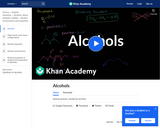
This 7-minute video lesson looks at naming alcohols. [Organic Chemistry playlist: Lesson 45 of 73].
- Subject:
- Chemistry
- Physical Science
- Material Type:
- Lecture
- Unit of Study
- Author:
- Khan, Salman
- Date Added:
- 02/20/2011

This 7-minute video lesson looks at naming alcohols. [Organic Chemistry playlist: Lesson 45 of 73].

This is the first course taken in a two sequence Organic Chemistry Course for science majors.
This course examines the behavior of hydrocarbons and their derivatives. Topics covered include alkanes, halides, alcohols, alkynes and stereochemistry.
Upon completion of this course the student will be able to perform the following: (1) Name organic compounds using both the IUPAC and Common System, (2) Determine the Stereochemistry of a compound, (3) Predict the products that will be formed from specific reactions, (4) Predict how changes in the structure of a compound can influence physical properties and reactivity, and (5) Understand the Importance of Mechanisms.

The organic chemistry course is organized as three modules: I. Molecular Architecture II. Molecular Transformations: Introduction to Organic Synthesis and Reaction Mechanisms III. Chemistry of

This course is designed for students majoring in a STEM area. It is the second sequence organic chemistry course.
This course examines the behavior of hydrocarbons and their derivatives. Topics covered include alcohols, alkynes, aldehydes, ketones, carboxylic acids, carboxylic acid derivatives, amines, and aromatic compounds.
Upon completion of this course the student will be able to perform the following: (1) Name organic compounds using both the IUPAC and Common System, (2) Determine the Stereochemistry of a compound, (3) Predict the major and minor products that will be formed from specific reactions, (4) Predict how modifications in chemical structure, including stereochemistry, can drastically change the physical and/or chemical behavior of compounds, and (5) Provide the mechanism for specific types of reactions.

This 7-minute video lesson provides an introduction to chirality. [Organic Chemistry playlist: Lesson 19 of 73].

Practice questions and exercises for the following: Unbranched Alkanes, Constitutional Isomers, Alkyl Substituents, Alkenes and Alkynes, Halogens, Benzene and Conjugation, Alcohols, Ethers, Aldehydes and Ketones, Carboxylic acids and Esters, Amines and Amides
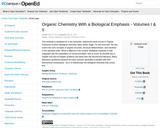
A free, open-access organic chemistry textbook (volumes I and II) in which the main focus is on relevance to biology and medicine. This is a PDF version of a wiki project called Chemwiki at the University of California, Davis. There are also supplementary materials, such as PowerPoint slides and a solutions manual available for this textbook at the Chemwiki website.

A second semester introductory physics course for life sciences students that looks to deepen students' understanding of biology and chemistry through physics all through the lens of understanding two of the most fundamental particles in the Universe: electrons and photons. The book begins with exploring the quantum mechanical nature of these objects to expand on what students have learned in chemistry and then proceeds to geometric optics (using the human eye as a theme), electrostatics (using membrane potentials), circuits (using the neuron), and finally synthesizing everything in a unit exploring the meaning of "light is an electromagnetic wave."
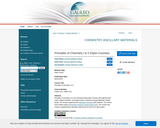
Principles of Chemistry I & II are LibGuides-based Open Courses with original lecture notes, chapter checklists, and original videos created by Georgia Highlands College faculty. The courses supplement the OpenStax Chemistry open textbook. The courses were created using a Round Nine Textbook Transformation Grant. The courses also contain a supplementary laboratory experiments list and set of video guides.

This course is an intensive survey of general, organic, and biological chemistry specifically designed for nursing majors and other health related fields. Topics include general chemistry, organic chemistry, and biological chemistry as applied to the chemistry of the human body.

The Soils Laboratory Manual, K-State Edition is designed for students in undergraduate, introductory soil science courses, and highlights the many aspects of soil science, including: soil genesis and classification, soil physical properties, soil-water interaction, soil biology, soil chemistry, and soil fertility. The lab manual includes 15 different laboratories, each one starting with an introduction and pre-lab assignment, followed by in-lab activities, and complimented by post-lab assignment. In-lab activities involve field trips, experiments, observation stations, or problem sets. Post-lab assignments include online quizzes, problem sets, or laboratory summary reports.
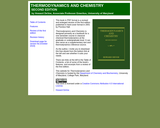
Thermodynamics and Chemistry is designed primarily as a textbook for a one-semester course in classical chemical thermodynamics at the graduate or undergraduate level. It can also serve as a supplementary text and thermodynamics reference source.
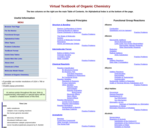
This virtual textbook allows for visualization of 3D-molecular models while teaching principles of Organic Chemistry. Before his retirement in 1999, Professor William Reusch began working on a virtual organic chemistry textbook that could be used by anyone with an interest in the subject. On this site, visitors can take advantage of his labors, and the introduction to this important subject offered on the homepage is a great place to start. After entering the main area of the site, visitors will find two columns of links that serve as the main table of contents. There are over twenty five topics covered here, and they include aromaticity, alkyl halides, alcohols, and amines. Each area contains lucid text accompanied by well-organized diagrams. Additionally, the site contains practice problems, incorporated into the text, along with links to external institutions such as the University of Wisconsin that offer additional problems. One area that shouldn't be missed is the "Chemicals and Society" area. Here visitors will find a narrative essay that addresses how the incorporation of different chemicals into air, water, and soil may affect human society over time.